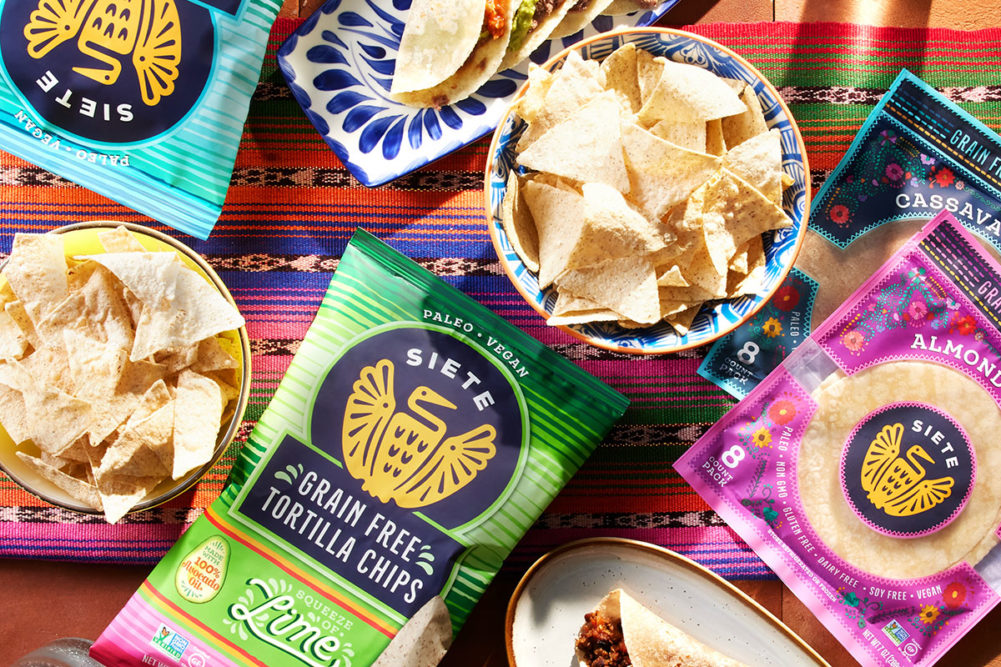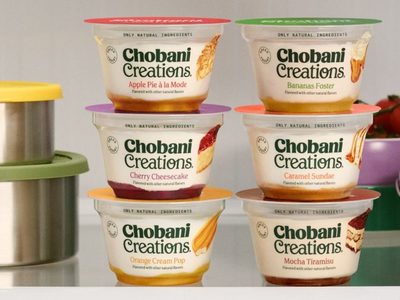AUSTIN, TEXAS — Adopting a grain-free diet more than a decade ago helped Veronica Garza manage symptoms of multiple autoimmune conditions. Still, she missed tacos and fajitas, the staples of her Mexican-American culture.
Experimentation in the kitchen resulted in the creation of a tortilla formulated with almond flour, a hit among friends, family and the local community of Laredo, Texas. Her homespun take on a Tex-Mex mainstay marked the beginning of Siete Family Foods, a Mexican-American food brand with $280 million in annual retail sales.
Ms. Garza, along with her parents and four siblings, launched the venture eight years ago. The team has grown to 100, led by chief executive officer (and youngest brother) Miguel Garza, who operates the company under a set of core values that includes “family first, family second, business third.”
Siete Family Foods markets and distributes a platform of heritage-inspired, wellness-driven products across the grocery store, including grain-free tortilla chips and taco shells, hot sauces and enchilada sauces, seasonings and dairy-free queso made from cashews. Recent additions include grain-free Mexican chocolate cookies, Mexican wedding cookies and Mexican shortbread cookies, and a line of kettle-cooked potato chips inspired by papitas sold at Mexican markets. Among other launches last year were a chorizo skillet cooking spice, a carnitas slow cooker spice and grain-free churro strips.
Formulations feature ingredients such as cassava flour, avocado oil, ground chia seeds, chickpeas and coconut sugar, selected to provide more nutritious options while accommodating various diets and dietary restrictions, according to the company.
Today, the company offers more than 60 stock-keeping units that are available at 16,000 retailers nationwide, including Whole Foods Market, Kroger, Target, Walmart and others.
Miguel Garza in an interview reflected on the evolution of Siete Family Foods and his hope for the future of the business and industry.
 The Garza family. (Photo: Siete Family Foods)
The Garza family. (Photo: Siete Family Foods)
Food Entrepreneur: When you sold your first grain-free tortilla, did you anticipate someday having such a broad portfolio of products?
Miguel Garza: At that point in time, no. We were making the product that my sister had created to solve a problem for herself. We had become a part of a community that had a similar problem, and so at that point in time when we were selling the product, it was really just making a product that people were excited to buy, and that was the main focus.
There really wasn’t any time to truly sit down and think about what we could be or what we wanted to be. It was mainly focused on, “How many tortillas can we make in an hour so that we can put them in a box and get them to a store?”
How has your approach to product development evolved over the past eight years?
Mr. Garza: I think as we’ve continued to grow as a business, we have done that introspective work to identify who we are and what we’re building and what we want to build and what we want that to look like.
When we’re talking about product development, my sister is our chief innovation officer, and she leads a team that includes our senior director of culinary and innovation, who is actually my best friend and freshman college roommate. When we’re evaluating where we want to go from an innovation standpoint, we really look at it from this framework that we are a better-for-you Mexican-American food brand, and we still want to bring products to market that we may miss that we’re no longer able to eat or purchase, or that we feel there’s an opportunity to bring more nutrient-dense or better ingredients to product offerings.
For us, does it fit those guardrails, and is it heritage-inspired? And are we bringing some level of innovation to the shelf?
If I were to talk to our culinary team, it’s almost as if the restrictions around what you can or can’t use, that resource constraint, actually breeds more innovation. I don’t think that we haven’t pursued innovation because of some of the challenges that the industry is facing. I think that we continue to be deliberate and methodical around where we want Siete to show up and where and what categories we think Siete should be serving the consumer.
Can you share recent examples of how you have executed on this approach?
Mr. Garza: We launched a line of beans recently. We launched refried black and refried pinto. They are both made with avocado oil. They’re both made with organic beans. More recently, we launched charro beans and ranchero beans. The charro bean is vegan, which is interesting because traditionally the charro bean, at least as we grew up eating them, has some sort of smoked or cured meat as a part of it, like sausage or bacon.
For us, it was, how can we present an offering that meets on the flavor profile and meets on the ingredient profile that people may be looking for and hits on the authenticity that we want to bring to market? And when I say “authenticity” I mean specific to me and my family and the foods we grew up eating.
And so, when I look at that line of beans, yeah, we’re bringing organic beans with cleaner ingredient profiles, so everything you can pronounce on the back of the package, and adding in avocado oil to the recipe. I’m really proud of those, and we’re really excited about them.
I think we’ve done that in other categories as well. We launched our grain-free cookies, which were a nod to these cookies we grew up eating that my grandma would make and my mom would make and even my sister would make. There we were able to add ingredients like almond flour and coconut sugar.
We’re always looking for ways where we can take some of these recipes that my sister and my mom and the team are making in their kitchens and bring them to life to share with the consumer.
What stand out as the biggest challenges of building this business?
Mr. Garza: I do think building a business is challenging in itself. Especially when you don’t have the experience or subject matter expertise. And that can be both a strength and a weakness. I think that we have in certain circumstances benefited from learning as we go and then in other circumstances have realized that having industry knowledge is actually very helpful. When I think about challenges, when we started this business, my sister and my mom and myself, we had this goal that we wanted to create something that we would be excited and proud to show up at every day. For us that meant when we laid out our core values that we wanted it to be initially an outpouring of some of the values of my family but similarly values that we felt would align with that vision of the organization that we wanted to build.
When you’re 10 people versus when you’re 40 people versus when you’re 80 to 100, when you want to build that place that stays true to its core values and stays true to that culture, that presents a challenge in itself where you’re really trying to figure out how to scale these values.
I think that’s often forgotten because you write down core values and maybe you put them in a drawer somewhere and when you hire somebody new you show it to them, but we really do try to live them out, and one of the things that I’ve been thinking about is that the core values stay the same, but that as business grows, the way those core values are expressed may look different.
When you’re 10 people, the way you communicate, interact, work together, it’s just different when you’re 50 and different when you’re 100. I think that’s been a worthwhile and rewarding challenge because we still enjoy showing up here every day, and we’ve actually been so fortunate that we’ve been able to grow the team but also grow the amount of family that’s on the team. You have all seven of us, the full siete, and then you have my wife, who’s our senior director of branding and creative, my brother-in-law who’s also on the team, and my niece. So there’s actually 10 of us on the team. I think that even that’s a worthwhile challenge.
It’s just making sure that we’re building something that we can continue to look forward to showing up to but also building something that when we look back in 10, 20, 30 years, that we’ll be proud of.
Where do you see the business in 10, 20, 30 years?
Mr. Garza: I normally have a hard time with this question mainly because I am not a vision board person or a write-all-my-goals-down person. I also don’t like being prophetic because I just know that if I could tell the future then I would probably not be doing what I’m doing.
But I can tell you what I believe to be true, which is we’re building a remarkable business with remarkable people. We are the fastest growing at scale Hispanic food or beverage brand. And that we are competing in and winning in growing categories.
And so when I think about 10, 20, 30 years down the road, I know it won’t be linear, but I do see Siete as a global iconic food brand. And the reason that I see that has more to do with the macroeconomic and macro demographic environment than it has to do with Siete specifically. I do think we are very well positioned to be in that environment, but I think it’s important to note from a macroeconomic standpoint, recent data showed that the US Latino would be the fifth largest GDP in the world. And I think maybe four years ago it was the ninth largest.
And the reason I think that’s important is because, one, it’s the spending power. It’s education and affluence… And then, what I don’t think gets talked about enough is when you take a step back, the influence that Latino culture is having domestically here in the US is probably unlike anything we’ve ever seen before … which will feed this cultural shift, which then plays out in flavor profiles at restaurants — whether it’s a Mexican restaurant or not, the influence will be there — and the products that are offered at grocery stores.
You’re probably going to see more tortillas, tortilla chips and different sauces and condiments from different Latino cultures into the future.
It’s exciting to be in that environment and to be positioned where we are, and I think it’s important to note that even though Latinos are starting businesses faster than any other group and actually performing really well with those businesses, they are still dramatically underfunded from a venture capital perspective.
My hope is that if we can be successful, and I now think we have a responsibility to be successful, that we will create a new pattern where we change that statistic into the future.
What is the most significant factor that you attribute to your success?
Mr. Garza: People and specifically the team. Me and my family are incredibly fortunate that we get to work with some of the most humble yet hardworking and incredibly capable and intelligent individuals across the board.
I don’t know how we have been so fortunate, but I think we count it as one of the biggest reasons that we’ve had any success.




